Hoshizaki WF27A01, SR36A15M, WR27AD2, UR27ALP, WR27A User Manual
...
Service Manual
Steelheart Series
Refrigerated Kitchen Equipment
Models
Undercounter
Worktop
Prep Table
|
|
|
|
|
hoshizakiamerica.com |
Number: 73217 |
|
|
|
|
|
||
|
|
|
|
|
Issued: 11-2-2018 |
|
|
|
|
|
|
|
|
|
|
|
|
|
|
|
|
|
|
|
|
|
|
|
|
|
|
|
|
|
|
|
|
|
|
|
|
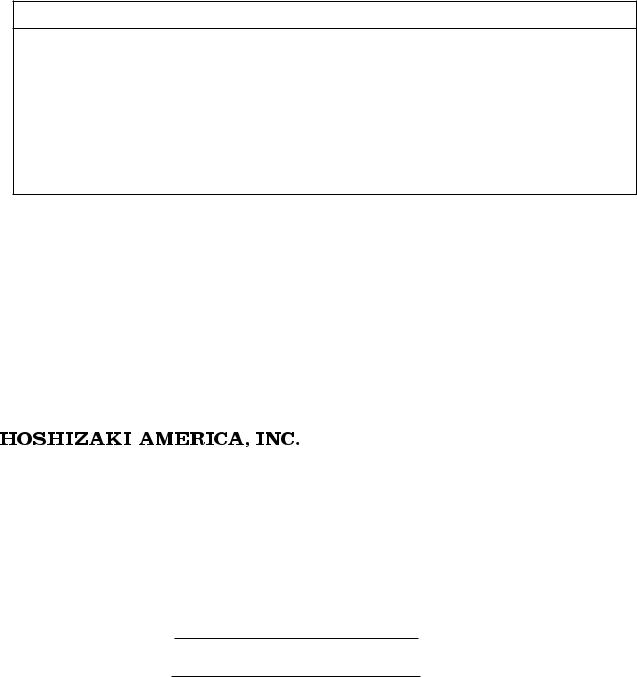
 WARNING
WARNING
Only qualified service technicians should install and service the appliance. To obtain the name and phone number of your local Hoshizaki Certified Service
Representative, visit www.hoshizaki.com. No service should be undertaken until the technician has thoroughly read this Service Manual. Failure to service and maintain the appliance in accordance with this manual will adversely affect safety, performance, component life, and warranty coverage. Proper installation is the responsibility of the installer. Product failure or property damage due to improper installation is not covered under warranty.
Hoshizaki provides this manual primarily to assist qualified service technicians in the service of the appliance.
Should the reader have any questions or concerns which have not been satisfactorily addressed, please call, send an e-mail message, or write to the Hoshizaki Technical
Support Department for assistance.
Phone: 1-800-233-1940; (770) 487-2331
Fax: 1-800-843-1056; (770) 487-3360
E-mail: techsupport@hoshizaki.com
618 Highway 74 South
Peachtree City, GA 30269
Attn: Hoshizaki Technical Support Department
Web Site: www.hoshizaki.com
NOTE: To expedite assistance, all correspondence/communication MUST include the following information:
•Model Number
•Serial Number
•Complete and detailed explanation of the problem.
2

IMPORTANT |
|
This manual should be read carefully before the appliance is serviced. Read |
|
the warnings and guidelines contained in this booklet carefully as they provide |
|
essential information for the continued safe use, service, and maintenance of the |
|
appliance. Retain this booklet for any further reference that may be necessary. |
|
CONTENTS |
|
Important Safety Information.................................................................................................. |
4 |
I. Construction and Refrigeration Circuit Diagram.................................................................. |
8 |
A. Construction................................................................................................................... |
8 |
B. Refrigeration Circuit Diagram......................................................................................... |
9 |
II. Sequence of Operation and Service Diagnosis................................................................ |
10 |
A. Sequence of Operation Flow Chart............................................................................. |
10 |
1. Undercounter and Work Top: Refrigerator............................................................... |
10 |
2. Prep Table: Refrigerator........................................................................................... |
11 |
3. Undercounter and Work Top: Freezer..................................................................... |
12 |
B. Service Diagnosis........................................................................................................ |
13 |
C. Control Module Check................................................................................................. |
18 |
D. Diagnostic Table........................................................................................................... |
20 |
III. Controls and Adjustments................................................................................................ |
23 |
A. Temperature Settings................................................................................................... |
23 |
B. Defrost......................................................................................................................... |
23 |
C. Safety Devices............................................................................................................. |
25 |
D. Perimeter and Mullion Heaters..................................................................................... |
25 |
IV. Refrigeration Circuit and Component Service Information.............................................. |
26 |
A. Refrigeration Circuit Service Information..................................................................... |
28 |
B. Component Service Information.................................................................................. |
31 |
V. Preparing the Appliance for Periods of Non-Use.............................................................. |
32 |
VI. Disposal.......................................................................................................................... |
33 |
VII. Technical Information..................................................................................................... |
34 |
A. Electrical and Refrigerant Data.................................................................................... |
34 |
B. Wiring Diagrams.......................................................................................................... |
35 |
1. Undercounter and Worktop: Refrigerator................................................................ |
35 |
2. Prep Table............................................................................................................... |
36 |
3. Undercounter and Work Top: Freezer..................................................................... |
37 |
3
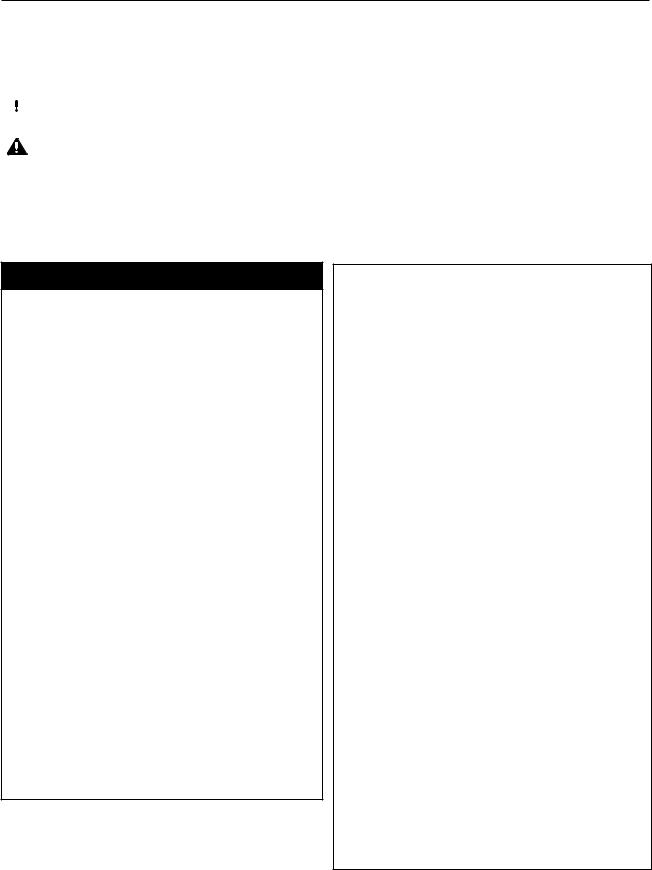
Important Safety Information
Throughout this manual, notices appear to bring your attention to situations which could result in death, serious injury, damage to the appliance, or damage to property.
DANGER |
Indicates a hazardous situation that, if not avoided, will result in |
|
death or serious injury. |
||
|
||
WARNING |
Indicates a hazardous situation that, if not avoided, could result |
|
in death or serious injury. |
||
NOTICE |
Indicates a situation that, if not avoided, could result in damage |
|
to the appliance or property. |
||
|
||
IMPORTANT |
Indicates important information about the use and care of the |
|
appliance. |
||
|
 DANGER
DANGER
Risk of Fire or Explosion
Flammable Refrigerant Used
•Follow handling instructions carefully in compliance with U.S. government regulations.
•Do not use mechanical devices to defrost.
•Do not puncture refrigerant tubing. Risk of fire or explosion due to puncture
of refrigerant tubing; follow handling instructions carefully.
•Component parts shall be replaced with like components.
•Servicing shall be done by factory authorized service personnel to minimize the risk of possible ignition due to incorrect parts or improper service.
•Consult instruction manual / service manual before attempting to install or service this product. All safety precautions must be followed.
•Dispose of properly in accordance with federal or local regulations.
•Do not place any potential ignition sources in or near the appliance.
Risque De Feu Ou D'Explosion
Le Frigorigène Est Inflammable
•Suivre attentivement les instructions de manipulation conformément à la réglementation gouvernementale.
•Ne pas utiliser d'appareils mécaniques pour dégivrer le réfrigérateur.
•Ne pas perforer la tubulure contenant le frigorigène. Risque de feu ou d'explosion si la tubulure contenant le frigorigène est perforée; suivre les instructions de manutention avec soin.
•Les pièces des composants doivent être remplacées par des pièces et accessoires
équivalents.
•L’entretien doit être effectué par le personnel de service autorisé par le fabricant afin de minimiser les risques d’inflammation attribuables à l’installation d’une pièce inadéquate ou à la mauvaise exécution du service.
•Consulter le manuel du propriétaire/ guide de réparation avant de tenter une réparation. Toutes les mesures de sécurité doivent être respectées.
•Éliminer conformément aux règlements fédéraux ou locaux.
•Ne placez aucune source d’inflammation potentielle dans ou près de l’appareil.
4
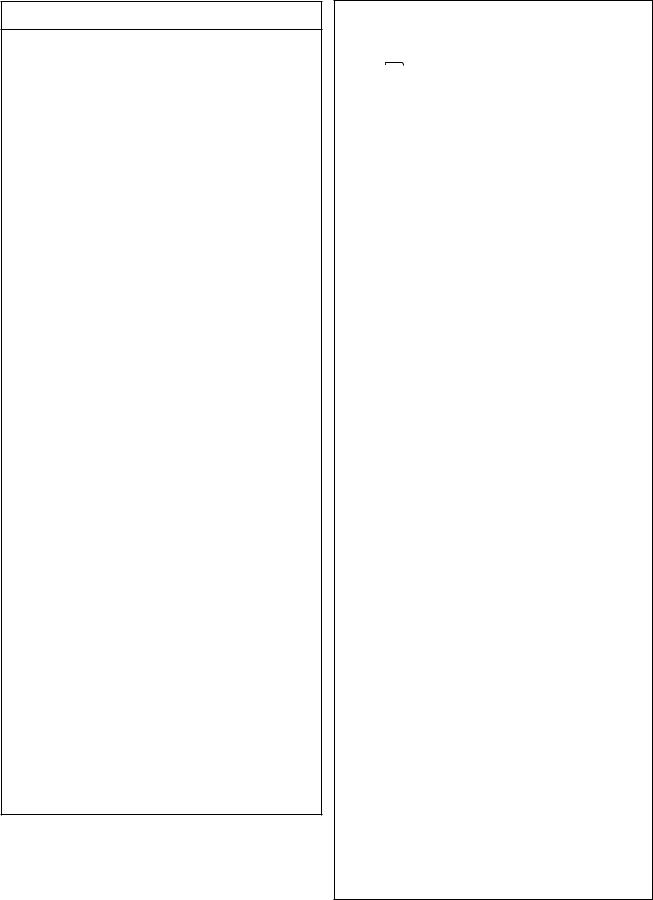
 WARNING
WARNING
The appliance should be destined only to the use for which it has been expressly conceived. Any other use should be considered improper and therefore dangerous. The manufacturer cannot be held responsible for injury or damage resulting from improper, incorrect, and unreasonable use. Failure to install, operate, and maintain the appliance
in accordance with this manual will adversely affect safety, performance, component life, and warranty coverage.
To reduce the risk of death, electric shock, serious injury, or fire, follow basic precautions including the following:
•Only qualified service technicians should install and service the appliance.
•Wear appropriate personal protective equipment (PPE) when servicing the appliance.
•The appliance must be installed in accordance with applicable national, state, and local codes and regulations.
•Appliance is heavy. Use care when lifting or positioning. Work in pairs when needed to prevent injury or damage. Do not lift using the top section or the doors/drawers.
•To reduce the risk of electric shock, do not touch the plug with damp hands.
•Unplug the appliance before servicing.
•The appliance requires an independent power supply of proper capacity. See the nameplate for electrical specifications. Failure to use an independent power supply of proper capacity can result in a tripped breaker, blown fuse, damage to existing wiring, or component failure. This could lead to heat generation or fire.
• THE APPLIANCE MUST BE
GROUNDED. The appliance is equipped with a NEMA 5-15 three prong grounding plug 



 to reduce the risk of potential shock hazards. It must be plugged into a properly grounded, independent 3-prong wall outlet. If the outlet is a 2-prong outlet, it is your personal responsibility to have a qualified electrician replace it with a properly grounded, independent 3-prong wall outlet. Do not remove the ground
to reduce the risk of potential shock hazards. It must be plugged into a properly grounded, independent 3-prong wall outlet. If the outlet is a 2-prong outlet, it is your personal responsibility to have a qualified electrician replace it with a properly grounded, independent 3-prong wall outlet. Do not remove the ground
prong from the power cord and do not use an adapter plug. Failure to follow these instructions may result in death, electric shock, or fire.
•Do not use an extension cord.
•Do not use an appliance with a damaged power cord. The power cord should not be altered, jerked, bundled, weighed down, pinched, or tangled. Such actions could result in electric shock or fire. To unplug the appliance, be sure to pull the plug, not the cord, and do not jerk the cord.
•The GREEN ground wire in the factoryinstalled power cord is connected to the appliance. If it becomes necessary to remove or replace the power cord, be sure to connect the power cord's ground wire.
•Do not splash, pour, or spray water directly onto or into the appliance. This might cause short circuit, electric shock, corrosion, or failure.
•Do not make any alterations to the appliance. Alterations could result in electric shock, injury, fire, or damage to the appliance.
•The appliance is not intended for use by persons (including children) with reduced physical, sensory, or mental capabilities, or lack of experience and knowledge, unless they have been given supervision or instruction concerning use of the appliance by a person responsible for their safety.
5

 WARNING, continued
WARNING, continued
•Children should be properly supervised around the appliance.
•Do not climb, stand, or hang on the appliance or doors/drawers or allow children or animals to do so. Do not climb into the appliance or allow children or animals to do so. Death or serious injury could occur or the appliance could be damaged.
•Be careful not to pinch fingers when opening and closing the doors/drawers or rail cover (prep table models) or when handling food pans. Be careful when opening and closing the doors/drawers or rail cover when children are in the area.
•Open and close the doors/drawers and rail cover (prep table models) with care. Opening the doors/drawers or rail cover too quickly or forcefully may cause injury or damage to the appliance or surrounding equipment.
•Do not use combustible spray or place volatile or flammable substances in or near the appliance. They might catch fire.
•Keep the area around the appliance clean.
Dirt, dust, or insects in the appliance could cause harm to individuals or damage to the equipment.
•Do not throw anything onto the shelves
or load any single shelf with more than 120 lb. (54.5 kg) of product. They might fall off and cause injury.
•Do not load any single drawer with more than 75 lb. (34 kg) of product. Depending on the weight of product in the drawers, secure the unit as necessary to prevent it from overturning. Do not open more than one drawer at a time.
•The appliance is designed only for temporary storage of food. Employ sanitary methods. Use for any other purposes (for example, storage of chemicals or medical supplies such as vaccine and serum) could cause deterioration of stored items.
•Do not block air inlets or outlets, otherwise cooling performance may be reduced.
•Do not tightly pack the cabinet. Allow some space between items to ensure good air flow. Also allow space between items and interior surfaces.
•Do not put warm or hot foods in the cabinet. Let them cool first, or they will raise the cabinet temperature and could deteriorate other foods in the cabinet or overload the appliance.
•Food storage and handling must comply with applicable codes and regulations.
•All foods should be wrapped in plastic film or stored in sealed containers. Otherwise foods may dry up, pass their smells onto other foods, cause frost to develop, result in poor appliance performance, or increase the likelihood of cross contamination. Certain dressings and food ingredients, if not
stored in sealed containers, may accelerate corrosion of the evaporator, resulting in failure.
•Do not store items near air outlets. Otherwise, items may freeze up and crack or break causing a risk of injury or contamination of other food.
6

 WARNING, continued
WARNING, continued
Additional Warnings for Prep Table Models
•The entire rail must always be covered by rail dividers and pans (1/6 size, up to 6" (15 cm) deep). Otherwise, the appliance will not cool properly.
•Use only 1/6 size pans up to 6" (15 cm) deep. Do not use damaged pans.
•Ingredients must be pre-chilled to 37°F
(3°C) or less before placing in rail.
•Keep the rail cover closed when not actively preparing food.
•The rail is for keeping ingredients cool while preparing food. If not actively preparing food for a long period such as overnight, seal pans with plastic wrap in addition to closing the rail cover.
Depending on conditions, the cabinet temperature setting may need to be adjusted to prevent items from freezing. Alternatively, seal ingredients and store them in a refrigerator or freezer.
NOTICE
•Protect the floor when moving the appliance to prevent damage to the floor.
•Keep ventilation openings, in the appliance enclosure or in the built-in structure, clear of obstruction. Do not place anything on top of the appliance in an undercounter installation. There must be at least 1.5" (4 cm) overhead clearance for proper ventilation. The factory-installed rear bumpers must be in place to ensure proper rear clearance. Blockage of airflow could negatively affect performance and damage the appliance.
•Do not allow the appliance to bear any outside weight.
•To prevent deformation or cracks, do not spray insecticide onto the plastic parts or let them come into contact with oil.
•To avoid damage to the gasket, use only the door/drawer handle when opening and closing.
•To avoid damage to the top seal, do not lift the appliance by the top panel or remove the top panel.
Additional Notice for Prep Table Models
•Do not place anything on top of the rail hood or rail cover and do not lift the appliance by the rail hood or rail cover.
The rail hood and rail cover are not designed to bear any outside weight.
7
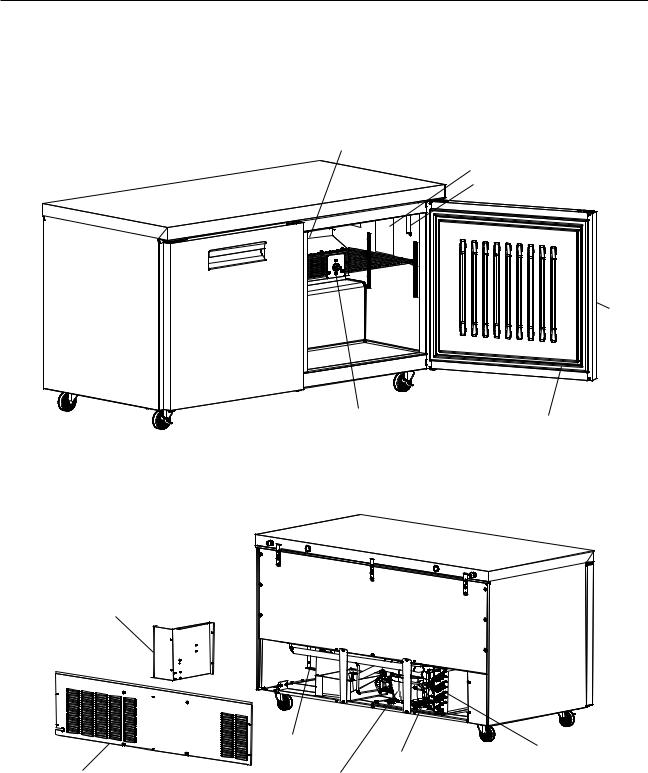
I. Construction and Refrigeration Circuit Diagram
A. Construction
1.Undercounter, Worktop, Prep Table Common Parts
•Evaporator
•Evaporator Fan
•Evaporator Fan Shroud
Nameplate
Thermometer
Door
Cabinet Temperature Control Dial
Door Gasket
Model Shown: UF60A
Control Module
Cover
|
Control |
Condenser |
|
Module |
|
|
Condenser Fan Motor |
|
|
|
|
Rear Panel |
Compressor |
|
|
Model Shown: UF60A |
|
8
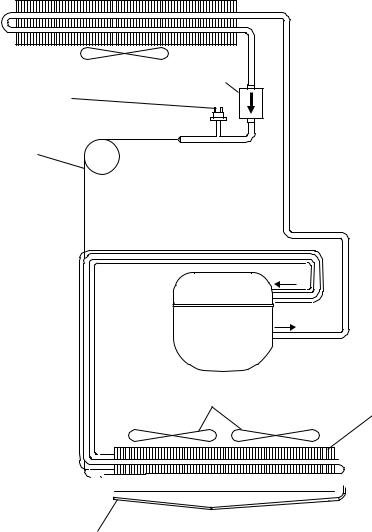
B. Refrigeration Circuit Diagram
Condenser
Condenser Fan |
Drier |
|
High-Pressure Switch
Capillary Tube
Compressor
Evaporator Fans
(1, 2, or 3 depending on model)
Evaporator













































































 Cabinet Thermostat Bulb
Cabinet Thermostat Bulb
Prep Table and Freezer Models: Defrost Heater, Defrost Safety Thermostat, and Defrost Thermistor
9
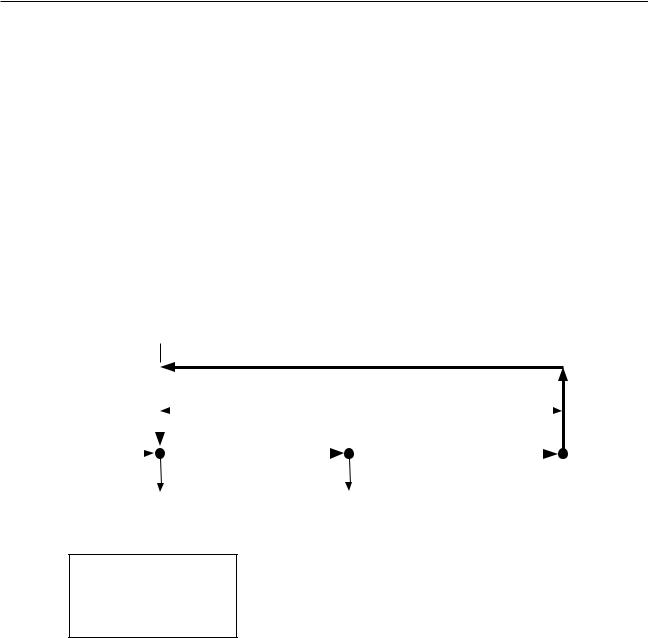
II. Sequence of Operation and Service Diagnosis
The steps in the sequence are as outlined below.
See the table for default cabinet temperature control settings.
Model |
Default Cabinet Temperature |
Approximate Default Temperature |
|
Control Setting |
|
Undercounter |
Between 4 and 5 |
Refrigerator: 34°F (1°C) |
Worktop |
|
Freezer: -5°F (-21°C) |
Prep Table |
Between 4 and 5 |
34°F (1°C) |
A. Sequence of Operation Flow Chart
1. Undercounter and Work Top: Refrigerator
Refrigerator Sequence Flow Chart
1. Startup/Cool Down |
|
2. Cool Down Achieved |
|
||
|
|
|
|
|
|
|
CTh above setpoint |
|
|
CTh cools to setpoint |
|||
|
|
|
|
|
|
|
|
|
|
|
|
|
|
|
|
CTh in |
control |
|
|
|
|
|
|
|
|
|
|
Off cycle defrost |
||||
|
|
|
|
2-min. Comp |
|
* |
|
|||
|
|
|
* |
|
|
2-min. Comp |
|
|
||
|
|
|
|
on timer starts |
|
between run cycles |
||||
Power on |
|
|
|
|
off timer starts |
|||||
|
|
|
|
|
|
|
|
|
|
|
Red LED On |
|
|
Green LED Flashes |
|
Green LED Flashes |
|||||
|
|
If Red LED flashes, check CTh |
|
If Red LED flashes, check CTh |
||||||
(5 sec. Delay) |
|
|
|
|||||||
|
|
|
|
|
|
|
|
|
||
|
|
Comp energized |
Comp de-energized |
|
|
|||||
|
|
ConFM energized |
ConFM de-energized |
|||||||
|
|
EvapFM energized |
EvapFM de-energized |
|||||||
CTh above setpoint
Legend: Comp-compressor
ConFM-condenser fan motor CTh-cabinet thermistor EvapFM-evaporator fan motor
Note: *Delays
a)2-min. minimum Comp on timer starts when Comp energizes.
b)2-min. minimum Comp off timer starts when Comp de-energizes.
10

11
Prep Table Top Sequence Flow Chart
|
|
|
1. Startup |
|
2. Cool Down |
|
|
|
3. Cool Down Achieved |
|
4. Defrost |
|
|
|
|
|
5. Defrost Termination |
||||||||||||||||
|
|
|
|
|
|
|
|
|
|
|
|
|
|||||||||||||||||||||
|
|
|
|
|
|
|
|
|
|
|
|
|
|
|
|
|
|
|
|
|
|
|
|
|
|
|
|
|
|
|
|
|
|
|
|
|
|
|
|
|
|
|
|
|
|
|
|
|
|
|
|
|
|
|
|
Defrost: |
|
|
|
|
|
Defrost Termination: |
|
|
|
||
|
|
|
|
|
|
|
|
|
|
|
|
|
|
|
|
|
|
|
|
|
|
|
|
|
|
|
|
|
|
||||
|
|
|
|
|
|
|
|
|
|
|
|
|
|
|
|
|
|
|
|
|
|
|
|
|
|
|
|
||||||
|
|
|
|
|
|
|
|
|
|
|
|
|
|
|
|
|
|
|
|
|
|
Time/Temp achieved. |
|
|
|
46°F (7.7°C) achieved or |
|
||||||
|
|
|
|
|
|
|
|
|
|
|
|
|
|
|
|
|
|
|
|
|
|
|
|
||||||||||
|
|
|
Red LED Off |
|
CTh above setpoint |
|
|
|
|
|
|
|
aboveCTh setpoint |
|
6-hr. DT terminates |
|
|
|
|
|
45 min. backup defrost |
|
|||||||||||
|
|
|
|
|
|
|
|
|
|
|
|
|
|
|
|
|
|
|
|
|
|
|
|
|
|
||||||||
|
|
|
Green LED Flashes |
|
|
|
CTh cools to setpoint |
|
|
Evap. temp. below |
|
|
|
|
|
timer terminated. |
|
|
|
||||||||||||||
|
|
|
|
|
|
|
|
CTh in |
|
control |
|
|
|
|
|
|
|
|
|
|
|
|
|
|
|
|
|
|
|||||
|
|
|
If Red LED Flashes, |
|
|
|
|
|
|
|
|
|
|
|
|
|
|
50°F (10°C) |
|
|
|
|
|
|
|
|
|
||||||
|
|
|
|
|
|
|
|
|
|
|
|
|
|
|
|
|
|
||||||||||||||||
|
|
|
check CTh or DTh |
|
|
|
2-min. Comp on |
|
|
2-min. Comp off |
|
|
|
|
|
|
|
|
DTh in control |
|
|
|
|
|
|
|
|
|
|||||
|
|
|
|
|
|
* |
|
|
|
|
* |
|
|
|
|
|
|
|
|
|
|
|
|
|
|
|
|
|
|
|
|
||
Power on |
|
|
|
|
|
|
|
timer starts |
|
|
|
timer starts |
|
|
|
|
|
|
|
|
|
|
|
|
|
|
|
|
|
|
|
||
|
|
|
|
|
|
|
|
|
|
|
|
|
|
|
|
|
|
|
|
|
|
|
|
|
|
|
|
|
|||||
|
|
|
|
|
|
|
|
|
|
|
|
|
|
|
|
|
|
|
|
|
|
|
|
|
|
|
|
|
|
|
|
|
|
Red LED On |
|
|
|
|
|
|
|
|
|
|
|
|
|
|
|
|
|
|
|
|
|
|
|
|
|
|
|
|
|
||||
(5 sec. Delay) EvapFM energized |
Comp energized |
EvapFM energized |
|
6-hr. DT terminates |
|
|
Evap. Temp. |
Defrost |
|||||||||||||||||||||||||
|
|
|
|
|
ConFM energized |
Comp de-energized |
*5-min. min. DT starts |
|
|
reaches 46°F (7.7°C) |
Terminated |
||||||||||||||||||||||
|
|
|
|
|
EvapFM energized |
ConFM de-energized *45-min. max. DT starts |
|
|
DH de-energized |
|
|
|
|||||||||||||||||||||
|
|
|
|
|
|
|
|
|
|
|
|
|
|
|
|
DH energized |
|
|
6-hr DT starts |
|
|
|
|||||||||||
|
|
|
|
|
|
|
|
|
|
|
|
|
|
|
|
Comp de-energized |
*After DOT Delay: |
|
|
|
|||||||||||||
|
|
|
|
|
|
|
|
|
|
|
|
|
|
|
|
ConFM de-energized |
|
|
Comp energized |
|
|
|
|||||||||||
|
|
|
|
|
|
|
|
|
|
|
|
|
|
|
|
EvapFM de-energized |
|
|
ConFM energized |
|
|
|
|||||||||||
|
|
|
|
|
|
|
|
|
|
|
|
|
|
|
|
|
|
|
|
|
|
|
|
|
|
|
After FDD |
|
|
|
|||
|
|
|
|
|
|
|
|
|
|
|
|
|
|
|
|
|
|
|
|
|
|
|
|
|
*EvapFM energized |
|
|
|
|||||
Legend: Comp-compressor
ConFM-condenser fan motor CTh-cabinet thermistor DH-defrost heater DT-defrost timer DTh-defrost thermistor
EvapFM-evaporator fan motor
Note: *Delays
a)2-min. minimum Comp on timer starts when Comp energizes.
b)2-min. minimum Comp off timer starts when Comp de-energizes.
c)5-min. minimum defrost time.
d)45-min. maximum defrost time.
e)DOT (drip off time) 1-min. Comp/ConFM delay timer starts when defrost termination temperature is met (drip off time (DOT)).
f)FDD (fan delay after defrost) EvapFM starts once 30-sec. EvapFM delay timer terminates or DTh reaches 40°F (4.4°C).
g)If evaporator temperature raises above 50°F (10°C) during the cooling cycle, 6-hr. DT resets.
Refrigerator Table: Prep .2
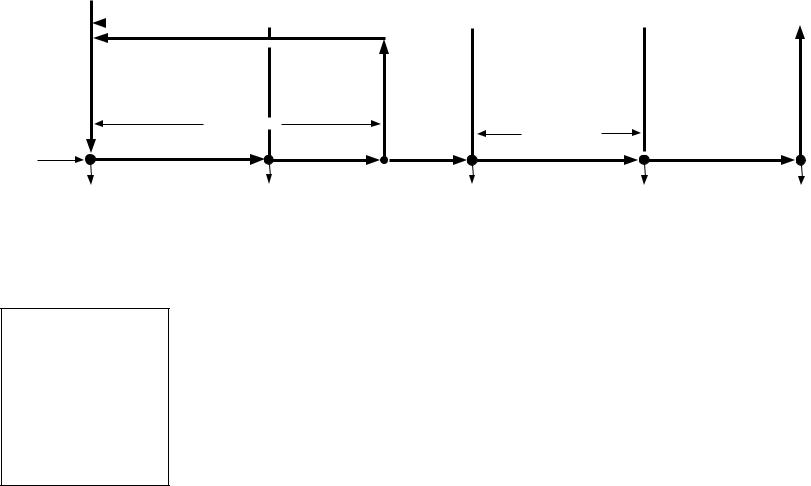
Freezer Sequence Flow Chart
1. Startup/Cool Down |
|
2. Cool Down Achieved |
|
3. Defrost |
|
5. Defrost Termination |
|
|
|
|
|||||
|
|
|
|
|
|
|
|
|
|
|
|
|
|
|
|
|
|
|
|
|
|
Defrost Initiation: |
Defrost Termination: |
|
|
Red LED off |
|
|
Setpoint |
|
Time/Temp achieved. |
50°F (°10C) achieved or |
|
|
Green LED Flashes |
Achieved |
CTh warms |
|
1 hr. backup defrost timer |
|
||
|
If Red LED flashes, |
|
|
terminated. |
|
|||
|
|
above |
|
|
||||
|
check CTh or DTh |
|
|
|
|
|||
|
|
setpoint |
8-hr. DT terminates |
|
|
|||
|
6-hr. or 8-hr. DT starts |
|
|
|||||
|
|
|
|
|||||
|
|
Evap. temp. below 41°F (5°C) |
|
|||||
|
|
|
|
CTh in control |
|
|
||
|
2-min. Comp on |
|
|
DTh in control |
|
|
||
|
|
2-min. Comp off |
|
|
|
|||
Power on |
timer starts |
|
|
timer starts |
|
|
|
|
|
|
|
|
|
|
|
|
|
Red LED On |
|
|
|
|
|
|
|
|
(5 sec. Delay) |
Comp energized |
|
|
Comp de-energized |
|
8-hr. DT terminates |
DH de-energized |
Defrost |
|
ConFM energized |
|
|
ConFM de-energized |
|
Evap. temp. below 41°F (5°C) |
8-hr. DT starts |
Terminated |
|
EvapFM energized |
|
|
EvapFM de-energized |
|
5-min. min. DT starts |
After DOT Delay: |
|
|
MH energized |
|
|
MH de-energized |
|
60-min. max. DT starts |
*Comp energized |
|
12 |
PH energized |
|
|
PH de-energized |
|
DH energized |
ConFM energized |
|
|
|
|
|
|
Comp de-energized |
MH energized |
|
|
|
|
|
|
|
|
ConFM de-energized |
PH energized |
|
|
|
|
|
|
|
EvapFM de-energized |
After FDD |
|
|
|
|
|
|
|
MH de-energized |
EvapFM energized |
|
Legend: |
|
|
|
|
|
PH de-energized |
* |
|
|
|
|
|
|
|
|
||
Comp-compressor |
|
|
|
|
|
|
|
|
ConFM-condenser fan motor |
Note: |
Delays |
|
|
|
|
||
CTh-cabinet thermistor |
|
|
|
|
||||
|
|
|
|
* |
|
|
|
|
DH-defrost heater |
|
a) 2-min. minimum Comp on timer starts when Comp energizes. |
|
|
||||
DT-defrost timer |
|
b) 2-min. minimum Comp off timer starts when Comp de-energizes. |
|
|
||||
DTh-defrost thermistor |
|
c) 5-min. minimum defrost time. |
|
|
|
|
||
|
d) 1-hr. maximum defrost time. |
|
|
|
|
|||
EvapFM-evaporator fan motor |
|
|
|
|
|
|||
|
e) DOT (drip off time) 3-min. Comp/ConFM delay timer starts when defrost termination temperature is met (drip off time (DOT)). |
|||||||
MH-mullion heater |
|
|||||||
|
f) FDD (fan delay after defrost) EvapFM starts once 7-min. EvapFM delay timer terminates or DTh reaches 25°F (-4°C). |
|
||||||
PH-perimeter heater |
|
|
||||||
|
|
|
|
|
|
|
||
Freezer Top: Work and Undercounter .3
